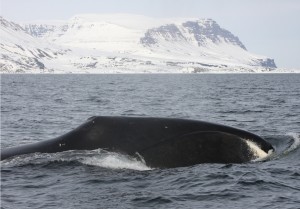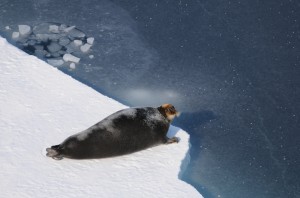
For Arctic marine mammals, the future is especially uncertain. Loss of sea ice and warming temperatures are shifting already fragile Northern ecosystems.
The precarious state of those mammals is underscored in a multinational study led by a University of Washington scientist, published this week in Conservation Biology, assessing the status of all circumpolar species and subpopulations of Arctic marine mammals, including seals, whales and polar bears. The authors outline the current state of knowledge and their recommendations for the conservation of these animals over the 21st century.
“These species are not only icons of climate change, but they are indicators of ecosystem health, and key resources for humans,” said lead author Kristin Laidre, a polar scientist with the UW Applied Physics Laboratory.
The overall numbers and trends due to climate change are unknown for most of the 78 populations of marine mammals included in the report: beluga, narwhal and bowhead whales; ringed, bearded, spotted, ribbon, harp and hooded seals; walruses; and polar bears.
The paper reviews population sizes and trends over time, if known, for each group, ranging from millions of ringed seals to fewer than a hundred beluga whales in Northern Canada’s Ungava Bay.
“Accurate scientific data – currently lacking for many species – will be key to making informed and efficient decisions about the conservation challenges and tradeoffs in the 21st century,” Laidre said.

The publicly available report also divides the Arctic Ocean into 12 regions, and calculates the changes in the dates of spring sea ice retreat and fall freeze-up from NASA satellite images taken between 1979 and 2013.
Reductions in the sea ice cover, it finds, are “profound.” The summer ice period was longer in most regions by five to 10 weeks. The summer period increased by more than 20 weeks, or about five months, in the Barents Sea off Russia.
The species most at risk from the changes are polar bears and ice-associated seals.
“These animals require sea ice,” Laidre said. “They need ice to find food, find mates and reproduce, to rear their young. It’s their platform of life. It is very clear those species are going to feel the effects the hardest.”

Whales may actually benefit from less ice cover, at least initially, as the open water could expand their feeding habitats and increase food supplies.
Approximately 78 percent of the Arctic marine mammal populations included in the study are legally harvested for subsistence across the Arctic.
“There’s no other system in the world where top predators support human communities the ways these species do,” Laidre said.
The study recommends:
- Maintaining and improving co-management with local and governmental entities for resources that are important to the culture and well-being of local and indigenous peoples.
- Recognizing variable population responses to climate change and incorporating those into management. In the long term, loss of sea ice is expected to be harmful to many Arctic marine mammals, however many populations currently exhibit variable responses.
- Improving long-term monitoring while recognizing monitoring for all species will be impossible. Alternatives include collecting valuable data from subsistence harvests, using remote methods to track changes in habitat, and selecting specific subpopulations as indicators.
- Studying and mitigating the impacts of increasing human activities including shipping, seismic exploration, fisheries and other resource exploration in Arctic waters.
- Recognizing the limits of protected species legislation. A balanced approach with regard to regulating secondary factors, such as subsistence harvest and industrial activity, will be needed, since protected species legislation cannot regulate the driver of habitat loss.
While the report aims to bring attention to the status and future of Arctic mammals, the authors hope to provoke a broader public response.
“We may introduce conservation measures or protected species legislation, but none of those things can really address the primary driver of Arctic climate change and habitat loss for these species,” Laidre said. “The only thing that can do that is the regulation of greenhouse gases.”
The report was funded by the Greenland Institute of Natural Resources and NASA. Co-authors are Harry Stern at the UW; Kit Kovacs, Christian Lydersen and Dag Vongraven at the Norwegian Polar Institute; Lloyd Lowry at the University of Alaska; Sue Moore at the U.S. National Marine Fisheries Service; Eric Regehr at the U.S. Fish and Wildlife Service in Anchorage; Steven Ferguson at Fisheries and Oceans Canada; Øystein Wiig at the University of Oslo; Peter Boyeng and Robyn Angliss at the Alaska Fisheries Science Center; Erik Born and Fernando Ugarte at the Greenland Institute of National Resources; and Lori Quakenbush at the Alaska Department of Fish and Game.
The study builds on a 2013 report by the Conservation of Arctic Flora and Fauna, a multinational group that advises the Arctic Council on biodiversity and conservation issues. Laidre was one of the lead authors for the chapter on marine mammals.
